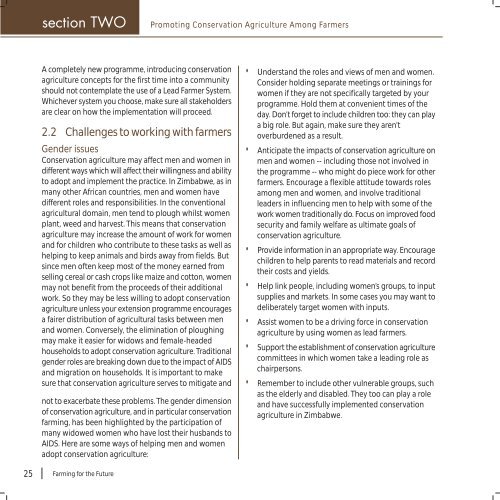A Guide to Conservation Agriculture in Zimbabwe - Canadian ...
A Guide to Conservation Agriculture in Zimbabwe - Canadian ...
A Guide to Conservation Agriculture in Zimbabwe - Canadian ...
You also want an ePaper? Increase the reach of your titles
YUMPU automatically turns print PDFs into web optimized ePapers that Google loves.
section TWO<br />
Promot<strong>in</strong>g <strong>Conservation</strong> <strong>Agriculture</strong> Among Farmers<br />
A completely new programme, <strong>in</strong>troduc<strong>in</strong>g conservation<br />
agriculture concepts for the first time <strong>in</strong><strong>to</strong> a community<br />
should not contemplate the use of a Lead Farmer System.<br />
Whichever system you choose, make sure all stakeholders<br />
are clear on how the implementation will proceed.<br />
2.2 Challenges <strong>to</strong> work<strong>in</strong>g with farmers<br />
Gender issues<br />
<strong>Conservation</strong> agriculture may affect men and women <strong>in</strong><br />
different ways which will affect their will<strong>in</strong>gness and ability<br />
<strong>to</strong> adopt and implement the practice. In <strong>Zimbabwe</strong>, as <strong>in</strong><br />
many other African countries, men and women have<br />
different roles and responsibilities. In the conventional<br />
agricultural doma<strong>in</strong>, men tend <strong>to</strong> plough whilst women<br />
plant, weed and harvest. This means that conservation<br />
agriculture may <strong>in</strong>crease the amount of work for women<br />
and for children who contribute <strong>to</strong> these tasks as well as<br />
help<strong>in</strong>g <strong>to</strong> keep animals and birds away from fields. But<br />
s<strong>in</strong>ce men often keep most of the money earned from<br />
sell<strong>in</strong>g cereal or cash crops like maize and cot<strong>to</strong>n, women<br />
may not benefit from the proceeds of their additional<br />
work. So they may be less will<strong>in</strong>g <strong>to</strong> adopt conservation<br />
agriculture unless your extension programme encourages<br />
a fairer distribution of agricultural tasks between men<br />
and women. Conversely, the elim<strong>in</strong>ation of plough<strong>in</strong>g<br />
may make it easier for widows and female-headed<br />
households <strong>to</strong> adopt conservation agriculture. Traditional<br />
gender roles are break<strong>in</strong>g down due <strong>to</strong> the impact of AIDS<br />
and migration on households. It is important <strong>to</strong> make<br />
sure that conservation agriculture serves <strong>to</strong> mitigate and<br />
not <strong>to</strong> exacerbate these problems. The gender dimension<br />
of conservation agriculture, and <strong>in</strong> particular conservation<br />
farm<strong>in</strong>g, has been highlighted by the participation of<br />
many widowed women who have lost their husbands <strong>to</strong><br />
AIDS. Here are some ways of help<strong>in</strong>g men and women<br />
adopt conservation agriculture:<br />
• Understand the roles and views of men and women.<br />
Consider hold<strong>in</strong>g separate meet<strong>in</strong>gs or tra<strong>in</strong><strong>in</strong>gs for<br />
women if they are not specifically targeted by your<br />
programme. Hold them at convenient times of the<br />
day. Don’t forget <strong>to</strong> <strong>in</strong>clude children <strong>to</strong>o: they can play<br />
a big role. But aga<strong>in</strong>, make sure they aren’t<br />
overburdened as a result.<br />
• Anticipate the impacts of conservation agriculture on<br />
men and women -- <strong>in</strong>clud<strong>in</strong>g those not <strong>in</strong>volved <strong>in</strong><br />
the programme -- who might do piece work for other<br />
farmers. Encourage a flexible attitude <strong>to</strong>wards roles<br />
among men and women, and <strong>in</strong>volve traditional<br />
leaders <strong>in</strong> <strong>in</strong>fluenc<strong>in</strong>g men <strong>to</strong> help with some of the<br />
work women traditionally do. Focus on improved food<br />
security and family welfare as ultimate goals of<br />
conservation agriculture.<br />
• Provide <strong>in</strong>formation <strong>in</strong> an appropriate way. Encourage<br />
children <strong>to</strong> help parents <strong>to</strong> read materials and record<br />
their costs and yields.<br />
• Help l<strong>in</strong>k people, <strong>in</strong>clud<strong>in</strong>g women’s groups, <strong>to</strong> <strong>in</strong>put<br />
supplies and markets. In some cases you may want <strong>to</strong><br />
deliberately target women with <strong>in</strong>puts.<br />
• Assist women <strong>to</strong> be a driv<strong>in</strong>g force <strong>in</strong> conservation<br />
agriculture by us<strong>in</strong>g women as lead farmers.<br />
• Support the establishment of conservation agriculture<br />
committees <strong>in</strong> which women take a lead<strong>in</strong>g role as<br />
chairpersons.<br />
• Remember <strong>to</strong> <strong>in</strong>clude other vulnerable groups, such<br />
as the elderly and disabled. They <strong>to</strong>o can play a role<br />
and have successfully implemented conservation<br />
agriculture <strong>in</strong> <strong>Zimbabwe</strong>.<br />
25 Farm<strong>in</strong>g for the Future
















